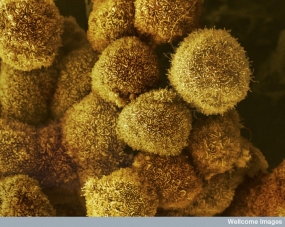New Technology Discovers Unknown Risk Genes for Pancreatic Cancer
Cancer is a complex disease of the genes. The reasons why a tumor develops are often unknown. An international team of researchers from the German Cancer Consortium (DKTK) and the Welcome Trust Sanger Institute has now developed a technique that can identify causes of cancer invisible to genetic sequencing. The technique has uncovered large sets of previously unknown pancreatic cancer genes. It is hoped that this study will boost research into a disease that is still poorly understood and for which five-year survival rates have stood at around 5 per cent for the past four decades.
The technique works by introducing sections of DNA called piggyBac transposons into the mouse genome. Transposons jump around within the genome, reinserting themselves at random and causing a different mutation in each cell of the mouse. This triggers cancer development, and tracking the transposon´s fingerprints in the tumors allows discovery of the affected cancer-causing genes. The PiggyBac tool was engineered for the first time to allow cancer induction in individual tissues within the mouse, and the method can now be used to study any type of cancer.
While genome sequencing can identify all categories of genetic alterations with high accuracy, some of these changes are difficult to interpret. For example, hundreds or thousands of genes are found to be transcriptionally or epigenetically dysregulated within a cancer, meaning that they are not mutated but just being turned on or off. Pinpointing the few cancer-causing events among these large gene sets is extremely difficult. PiggyBac screening can facilitate this search for the needle in the haystack because transposons jump directly into the relevant genes. Moreover, the tool monitors tumor development in mice and therefore researchers are also able to see the consequences of cancerous mutations and how they help the disease to progress.
“Recent advances in cancer genome sequencing have given extraordinary insights into the genetic events underlying cancer. Nevertheless, we are still far from understanding the complexity of the molecular processes driving cancer development,” says Professor Roland Rad, from the Technische Universität München, the German Cancer Consortium (DKTK) and the German Cancer Research Center (DKFZ). “Unbiased genome-wide screening in mice allows us to see cancer from a different angle and answer biological questions that cannot be addressed with other approaches.”
The study has identified many genes previously unknown to be involved in pancreatic cancer, including Foxp1, which was hit by transposons at very high frequencies in the 49 mouse tumors studied. Where Foxp1 was induced, tumors spread from the pancreas to other organs, suggesting that the gene drives cancer progression. This finding was confirmed when researchers looked at human samples and found high levels of the FOXP1 gene product in cancers that had metastasized.
“PiggyBac has discovered novel players in pancreatic cancer and additional experiments in mice allowed us to unravel the biological role of selected genes, such as Foxp1, at an organismal level. We then still need to confirm our findings in human cancer samples but many genes could not have been identified in first place with the traditional screening techniques in humans”, says Prof. Dieter Saur from the Technische Universität München.
In a number of mice, transposons had become inserted in noncoding regions of the genome. These insertions pinpointed enhancer areas, which are involved in the regulation of cancer-causing genes. In addition, similarly to humans, mice developed various subtypes of pancreatic cancer, which not only have distinctive microscopic appearances but also show different clinical behaviors. The study discovered molecular processes being responsible for triggering the formation of these cancer subtypes.
“Progress in treating pancreatic cancer has been held back because we don’t yet understand the disease properly,” says Professor Allan Bradley, Director Emeritus of the Sanger Institute. “PiggyBac can be used in concert with Sleeping Beauty, another transposon tool, and alongside whole genome sequencing to enable us to see, in great detail, the origins of this cancer.”
Researchers will now be able to look more closely at the pancreatic cancer genes that have been discovered by this study in the hope of finding effective drugs for a disease that is set to be the second leading cause of cancer death by 2030. Laboratories have also begun using the technique to investigate cancers in other tissues.
Rad, R., Rad, L., Wang, W., Strong, A., Ponstingl, H., Bronner, I.F., Mayho, M., Steiger K., Weber, J., Hieber, M., et al. (2014). A conditional piggyBac transposition system for genetic screening in mice identifies oncogenic networks in pancreatic cancer. Nature Genetics 2014, doi:10.1038/ng.3164
With more than 3,000 employees, the German Cancer Research Center (Deutsches Krebsforschungszentrum, DKFZ) is Germany’s largest biomedical research institute. DKFZ scientists identify cancer risk factors, investigate how cancer progresses and develop new cancer prevention strategies. They are also developing new methods to diagnose tumors more precisely and treat cancer patients more successfully. The DKFZ's Cancer Information Service (KID) provides patients, interested citizens and experts with individual answers to questions relating to cancer.
To transfer promising approaches from cancer research to the clinic and thus improve the prognosis of cancer patients, the DKFZ cooperates with excellent research institutions and university hospitals throughout Germany:
The DKFZ is 90 percent financed by the Federal Ministry of Education and Research and 10 percent by the state of Baden-Württemberg. The DKFZ is a member of the Helmholtz Association of German Research Centers.


